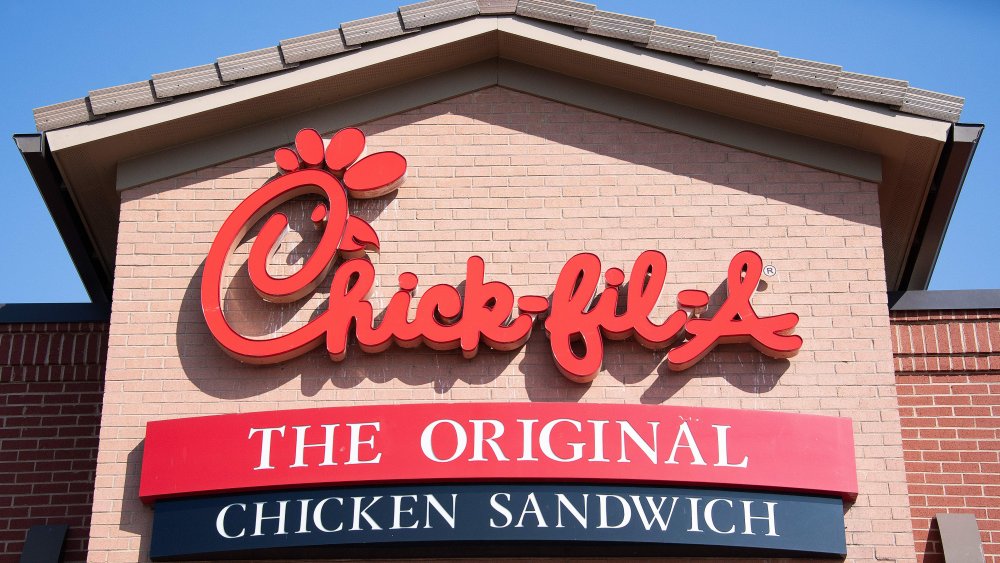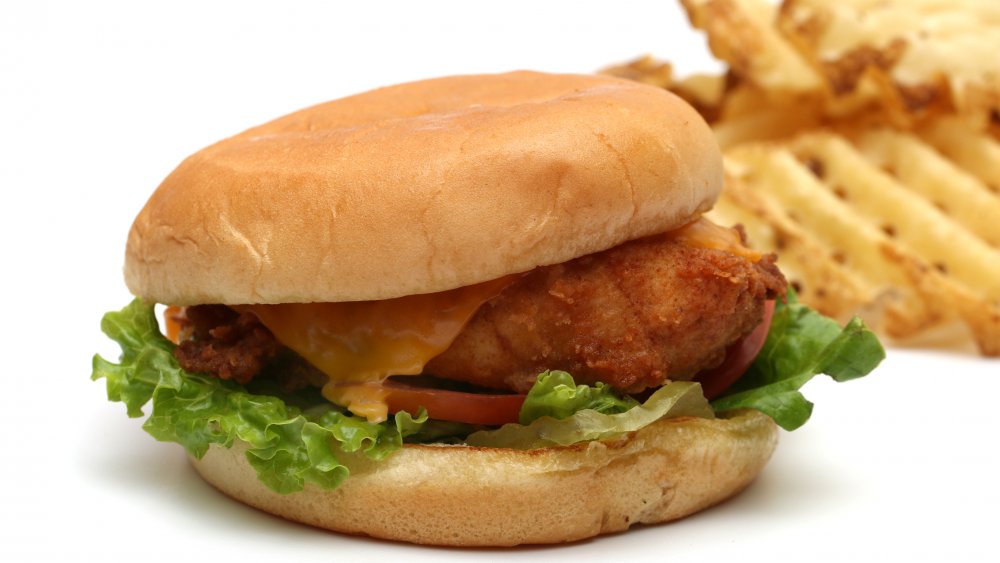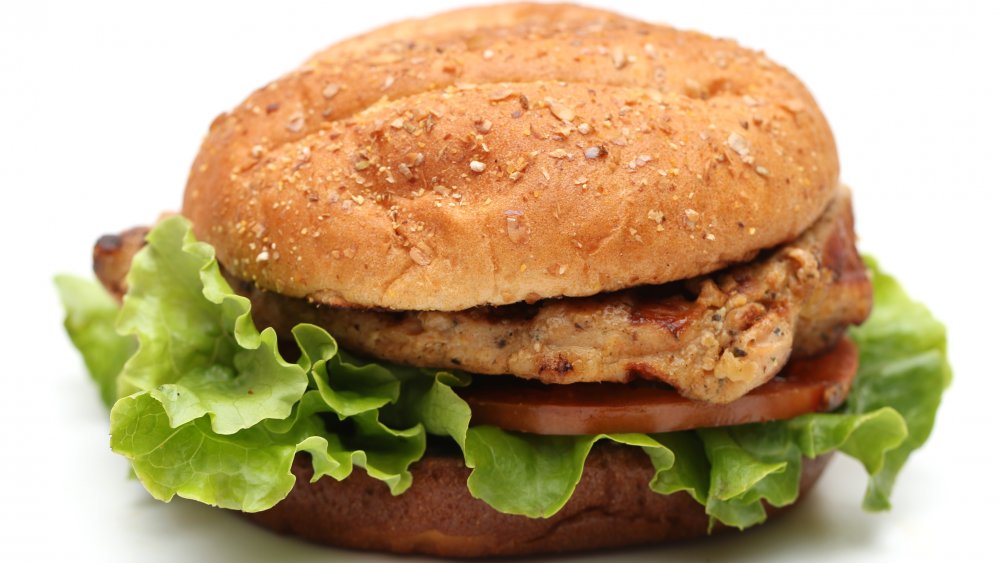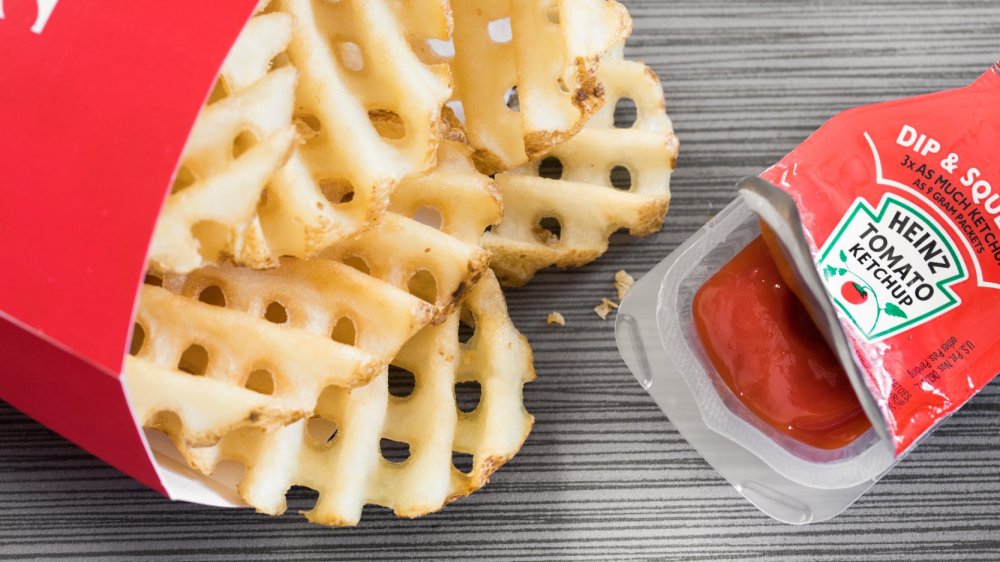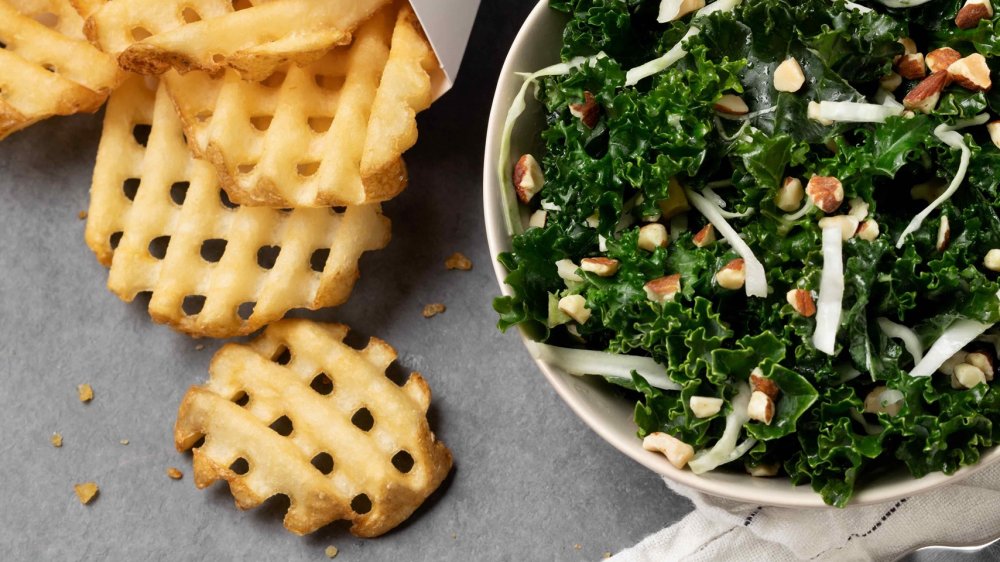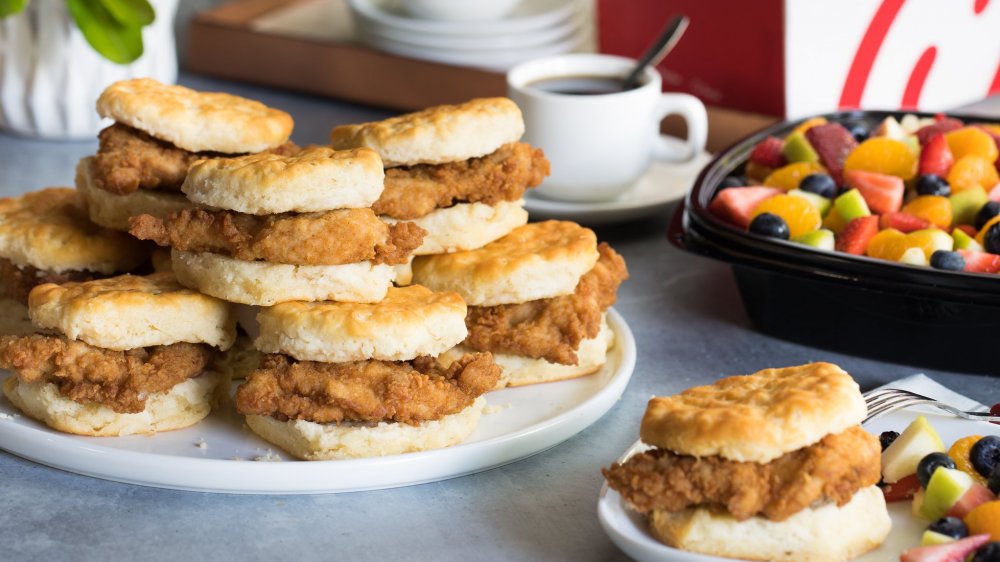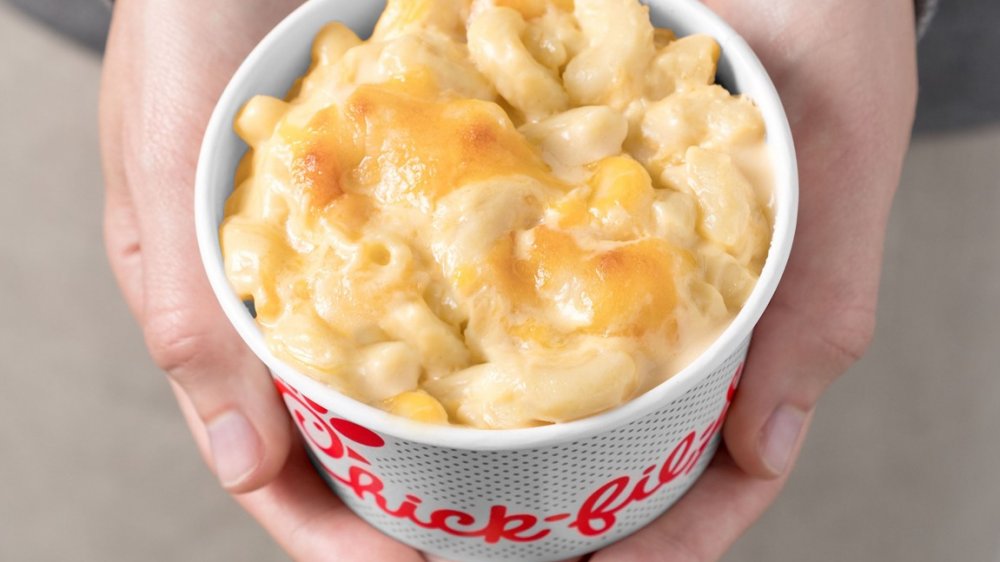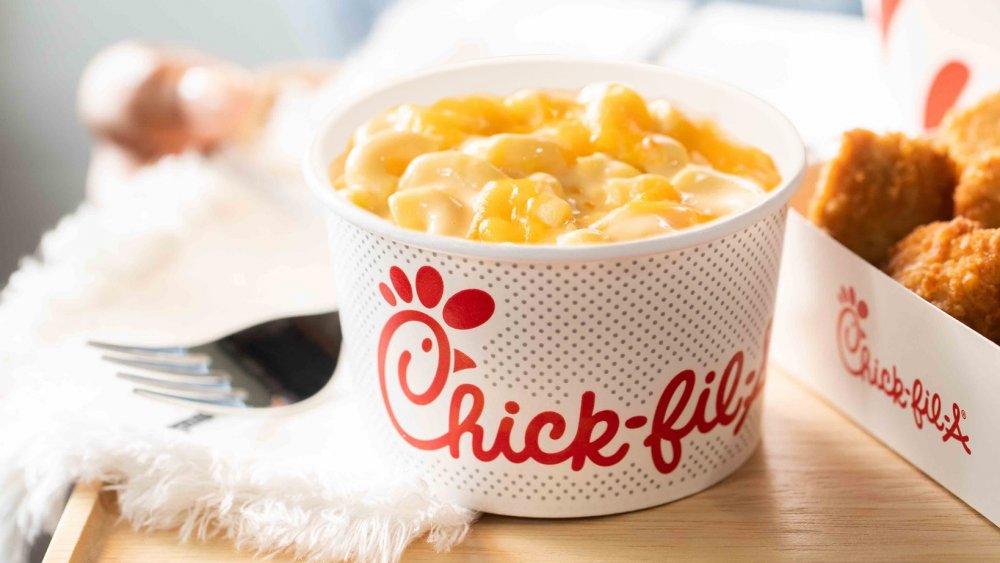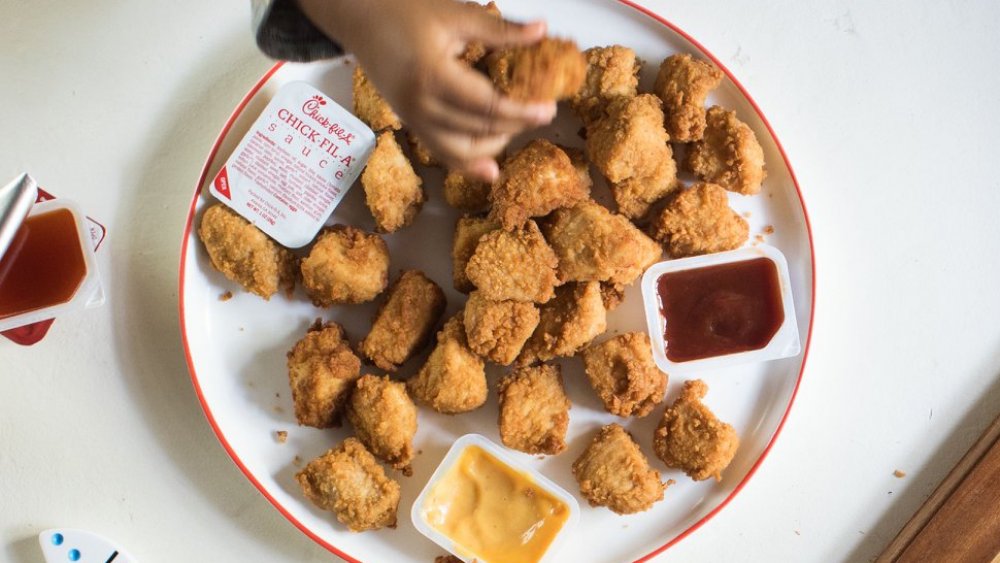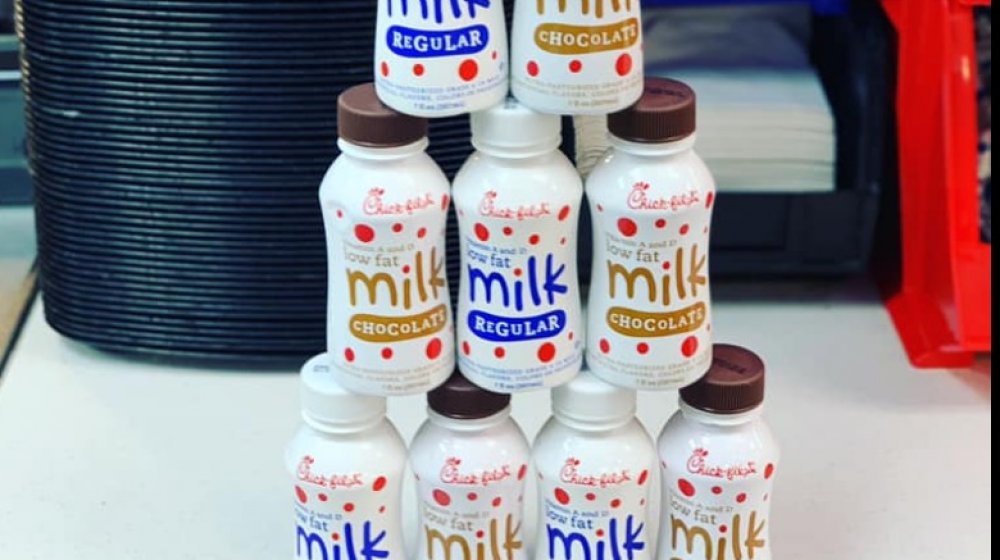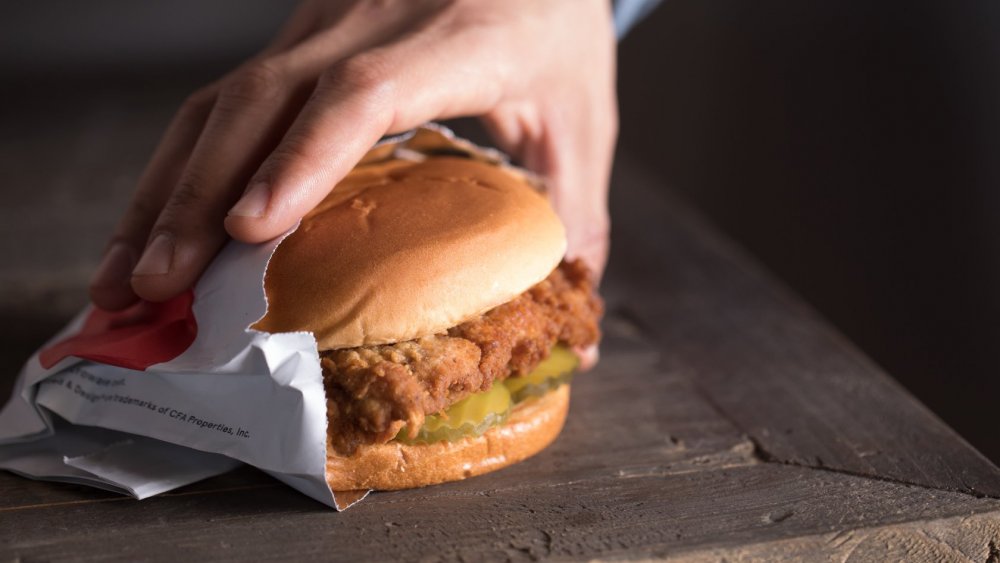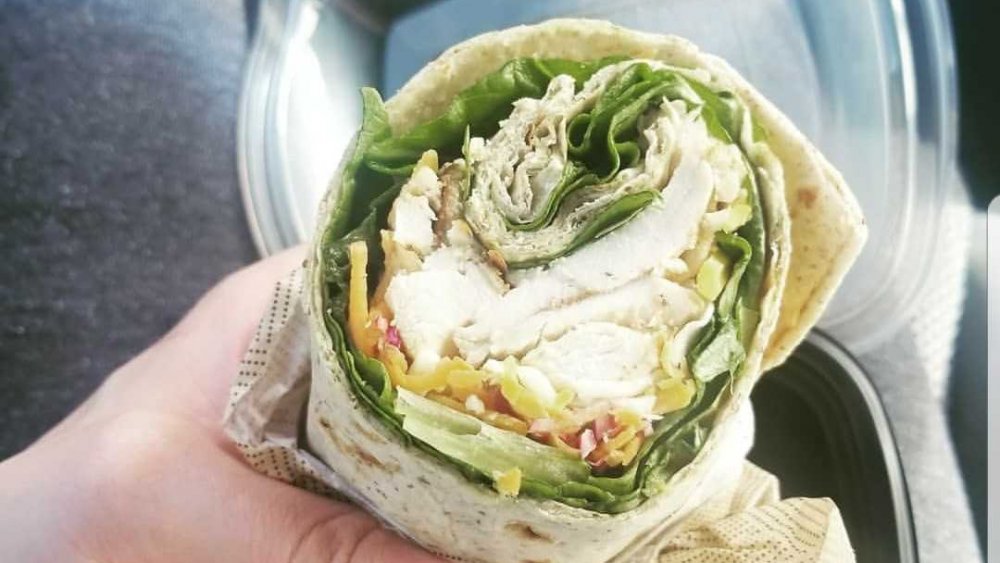What You're Really Eating When You Order Chick-Fil-A
When you pull through the drive-through at a Chick-fil-A, you probably plan on ordering chicken. It's practically a foregone conclusion given that chicken is right there in the fast-food restaurant's name. And chicken is chicken, right? Or is there really more to see behind the curtain of this popular fast food chain?
Obviously, Chick-fil-A features other crave-worthy menu items, like waffle fries, milkshakes, salads, and breakfast scrambles, so it's not just the chicken itself that deserves a second look. In a world where quick-serve restaurants are fighting for customer retention and spending obscene marketing dollars to bring you back week after week, it makes sense that they'd also do everything they can to make their food taste great. Sometimes these taste-enhancing tricks are benign and do little to interfere with your lifestyle or health, but sometimes they're a little less benign. At the end of the day, it's up to you to decide whether Chick-fil-A's nutrition content and food preparation match with your lifestyle, but here are a few of the things you're really eating when you stop at Chick-fil-A.
There's sugar in your Chick-fil-A chicken sandwiches
Okay, so it shouldn't come as a massive surprise that some Chick-fil-A products include sugar. Obviously, they sell food and drinks that run the gamut from sodas and shakes to fruit cups and cookies, all of which are rife with sugar content. Plus, sugars are commonly found (both naturally and as additives) in breads, fruits, and vegetables. But what may throw you for a loop is the fact that Chick-fil-A's chicken includes added sugars.
And it's not just the breaded chicken that has sugar in it, which makes sense given that breading adds carbohydrates to the food you're eating. It's Chick-fil-A's grilled chicken that includes sugar listed as an ingredient in the chicken. Take, for instance, an order of grilled chicken nuggets. Theoretically, it should only include chicken as an ingredient. But if you look at the list of ingredients included in an order of grilled chicken nuggets on the Chick-fil-A website, you'll see 25 different items included, such as spices, preservatives, and... you guessed it, sugar. Granted, the total sugar content is just one gram, so it's not like they've added a massive amount of sugar to their grilled chicken, but it's something to keep in mind. Especially when ordering some of their other sandwiches. For instance, the Grilled Chicken Sandwich and Grilled Chicken Club both contain 9 grams of sugar, something you can check on the company's nutrition information web page.
Your Chick-fil-A grilled chicken has apple cider vinegar
It may seem strange that Chick-fil-A's grilled chicken has so many ingredients included as part of the chicken itself, but if you think about it, it's not that weird. When you prepare chicken at home, do you ever prepare it completely plain without any added spices or marinades? Probably not. And really, the 25 ingredients included in Chick-fil-A's grilled chicken (you can find them listed on each product's individual web page, like the Grilled Chicken Club page), are mostly part of the brine used to give the chicken the delicious flavor you just can't get enough of. And what's at the base of that brine? Apple cider vinegar.
The apple cider vinegar, along with a slew of other flavorings, including molasses, dehydrated onion, sea salt, lemon juice, and paprika (just to name a few), help to give Chick-fil-A's chicken the consistent moist and full flavor you've come to expect. And let's be honest — grilled chicken nuggets without a tangy brine would be pretty bland. Prepped and cooked like this? It's something you're actually willing to pay for.
Waffle fries from Chick-fil-A are made with an anti-foaming agent
Uhhhhh... Chick-fil-A waffle fries should just consist of potatoes, salt, and oil, right? Welp, that's where you're wrong. The website's list of ingredients for this fan-favorite is actually comparably short to most other Chick-fil-A foods, but it's still longer than you might imagine, consisting of potatoes (with four sub-ingredients, including two different oils, dextrose, and some long, chemically-sounding agent used to promote color retention), sea salt, and canola oil. All more-or-less benign, until you notice that the canola oil is actually listed as high oleic canola oil with (wait for it), dimethylpolysiloxane added as an anti-foaming agent.
What's an anti-foaming agent, you ask? Great question. When former Mythbusters host Grant Imahara dissected McDonald's use of 19 ingredients in their french fries, he explained it's an additive in oil that helps prevent the oil from splashing (via HuffPost). Again, it seems fairly benign. And it might be — it's not entirely clear. Some food critics, like the popular blogger, Food Babe, question the safety of this product being put in food, as it's outlawed in Europe, even though she also points out that the FDA has approved its use in very small amounts. Really it comes down to buyer beware — if your waffle fry fix is an occasional affair and not an everyday occurrence, you probably don't have to worry too much.
Your Chick-fil-A kale salad comes with a dash of white wine
Chick-fil-A's Kale Crunch Side Salad is arguably one of the healthiest items the quick-serve restaurant has on its menu, and most of the salad's ingredients are exactly what you'd expect — kale, green cabbage, almonds, and apple Dijon dressing. But wait a hot second before you chow down and take a full look at the ingredients in that "apple Dijon dressing," as listed on the Chick-fil-A website. After oil, apple juice concentrate, maple syrup, a few different vinegars, salt, and other seasonings, white wine appears as an unassuming side note.
To be fair, it's hardly unheard of for salads or dressings to include cooking wines, but for a restaurant with a highly conservative, Christian background (Chick-fil-A's are even closed on Sundays), it might catch some people off-guard. Those who are teetotalers for personal reasons, or those who subscribe to a Christian faith that eschews the use of alcohol in any amount, may want to ask for the apple Dijon dressing to be switched out for a dressing without a dash of wine. But good luck knowing which dressing that might be — none of the other dressings feature ingredient lists on the Chick-fil-A website.
Chick-fil-A ice cream cone? Nope, that's an Icedream cone
While you can't find Chick-fil-A's "Icedream" cone listed as an option on their website, the company notes that this frozen treat is one of their most popular menu items. To be clear, this is Icedream, not ice cream. Which is perplexing. Why is their soft-serve treat not actually ice cream? Why did they decide call it something different instead of the usual "soft serve?"
The ingredients, which can be found listed on their site as part of their Frosted Coffee and Frosted Lemonade (and also, technically, all of their milkshakes, although the ingredient lists for those are a little less clear that this is their Icedream product), sound awfully close to regular ice cream, including milkfats, sugar, and a lot of preservatives, flavorings, and additives to create the soft-serve consistency. All-in-all, it's a "no harm, no foul" type of ice cream-adjacent offering. And if they were just looking for a catchy name to draw interest to their product, it looks like they've succeeded.
Chick-fil-A uses butter oil
You know the golden stream of "buttery sauce" that gets pumped on top of popcorn at the movie theater? That's the epitome of "butter oil." It's basically just a bunch of different oils and salts and flavorings mixed together to taste like butter... but it's not really butter at all. For companies like Chick-fil-A, this "butter oil" — which is listed as an ingredient in their menu items like the Hash Brown Scramble Bowl and the Sausage, Egg & Cheese Biscuit – is cheaper to buy, easier to preserve, and has the melty consistency that is just so dang addicting.
Chick-fil-A's butter oil includes soybean oil, palm kernel oil, soy lecithin, natural flavor, and beta carotene (for that buttery yellow color). Nothing overly concerning here, except when you note that the menu items that include butter oil also include lots of other fats and oils as part of their ingredient lists. This means that the fat content is borderline obscene. For instance, the Sausage, Egg & Cheese Biscuit contains 43 grams of fat, 19 of which are saturated. If you're trying to keep your fat and calorie intake under control (this biscuit also features a whopping 630 calories), you might want to steer clear of menu items like this. If that sounds hard, just imagine someone making your food with a giant glob of movie theater "butter." Sure, it tastes good, but it looks pretty nasty. And it's not exactly a health food item.
There's processed cheese spread in your Chick-fil-A mac 'n cheese
Arguably, one of the worst things (health-wise, not taste-wise) on the Chick-fil-A menu is the restaurant's mac 'n cheese. If you've ever made mac 'n cheese from a box at home, you know it's not exactly filled with fresh ingredients — the neon orange cheese powder should be the dead giveaway. So if you were hoping Chick-fil-A's dedication to high-quality ingredients would ensure their mac 'n cheese would steer clear of processed cheese spread in favor of all-real cheeses, it's time to set those hopes aside — after macaroni, processed cheese is the second listed ingredient on the company's website.
Granted, it's still probably better than the made-from-a-box option you buy at a grocery store — they do include other cheeses, like cheddar cheese, bellavitano cheese, Romano cheese, and grated Parmesan cheese, so it's not all processed cheese. And to be fair, it's hard to get the creamy consistency of a delicious mac 'n cheese without using a processed cheese, but if you're the type who steers clear of "fake foods," you might want to make your mac 'n cheese at home (but try our from scratch Chick-fil-A copycat recipe instead of making it from a box).
Again, it's not butter... it's margarine, at Chick-fil-A
During the "fat backlash" of the 1980s and 1990s, the saturated fat in real butter, as well as the saturated fat in other solid fat products, like Crisco, received a backlash — people were terrified of eating too much fat, especially saturated. In response, companies started promoting margarine, which was solid at room temperature, like butter, but had fewer saturated fats because it was made by altering the chemical makeup of oils so that the oils would be solid.
The world rejoiced. The total fat content was more-or-less the same, but with lower saturated fats, margarine was considered "healthier." Unfortunately, it took several more decades to realize was that in the process of changing the chemical makeup of these oils, trans fats were created, and trans fats are actually associated more closely with heart disease than saturated fats are.
Unfortunately, some of Chick-fil-A's products, like their mac 'n cheese, include margarine as an ingredient, which means they might include trans fats. Here's where it gets confusing — if you look at the nutrition content of Chick-fil-A's mac 'n cheese on their website, it lists zero trans fats for a single serving, but 3.5 grams of trans fats for a tray of mac 'n cheese. How is this discrepancy possible? It all has to do with some tricky labeling loopholes.
Watch out for those trans fats at Chick-fil-A
As pointed out in an article written on Healthline, the Food and Drug Administration (FDA), has largely banned the use of trans fats in foods sold at grocery stores and restaurants due to their close association with heart disease. The problem, though, is that companies can list zero grams of trans fats in foods when the total amount of trans fats is less than .5 grams per serving. These trans fats get "hidden" without most people being aware that they're consuming them. Take, for instance, Chick-fil-A's mac n' cheese. If you look at the restaurant's nutrition website, there are zero trans fats listed for a single serving of mac n' cheese, but 3.5 grams of trans fats listed for a small tray of mac n' cheese (which is roughly 11 servings). This means that each serving has about .3 grams of trans fats, but unless you're digging for the information, you'd never know it. Tricky, tricky, right?
Chick-fil-A's products with trans fats don't end there — Chick-fil-A Sauce, Polynesian Sauce, and the Hash Brown Scramble Burrito all have .5 grams or more per serving. Also, the Garden Salad Tray has .5 grams total for a small tray, but to be fair, that breaks down to a minuscule amount per serving, so it's a little less concerning.
Just remember, these are the trans fats we know about – there could be more lurking in other items, but with fewer than .5 grams per serving, only Chick-fil-A knows.
There's corn starch in your Chick-fil-A chocolate milk
If your kids have been falling all over themselves to order the chocolate milk at Chick-fil-A — if they insist it's better than the chocolate milk they get at other places or that you serve at home — it might be because of a little-known secret for making a thicker, creamier drink — corn starch. Corn starch is a thickening agent, so whenever you're looking to make a thick, creamy soup, sauce, or drink, it's possible to add a little corn starch in the process to achieve the desired result. And considering that Chick-fil-A's chocolate milk uses a lower fat (i.e., less thick) one-percent milk, by including corn starch in its list of ingredients, your kids (or you — no one's judging) get to enjoy a creamier milk. So maybe the delicious texture and flavor are due to corn starch, but it's possible they're also due to a few of the other ingredients in Chick-fil-A's chocolate milk, like natural vanilla, carrageenan (another thickening agent), or even salt.
Chick-fil-A serves enough sodium, fat, and calories for your whole day
Okay, so here's the deal: Restaurants like Chick-fil-A have to make their food taste great (at a reasonable price) to keep luring customers back to their doors (or drive-thrus). And there are a few tried-and-true methods for making food taste great — salt, fat, and sugar. None of which are particularly good for you in large quantities.
And while Chick-fil-A does earn marks for sourcing their food more responsibly than many restaurants, and for trying to offer healthier options, as they detail on their website, they're still a fast food restaurant vying for market share in the world of McDonald's. This means many of their products (even the more "healthy" options) are loaded with sodium, fat, and sugar, which translates to an obscene number of calories, sodium, and fats.
Take, for instance, the Chick-fil-A Cobb Salad. It's a salad, right? So it must be good for you. Well... sorry, but maybe not. This salad has 540 calories, 29 grams of fat (8 of which are saturated), 7 grams of sugar, and a whopping 1,700 grams of sodium. Considering the FDA recommends limiting sodium to less than 2,300 grams of sodium a day, this "healthy salad" practically wipes out your daily allowance.
And that's one of the salads. If your doctor has recommended you keep an eye on your fat, sugar, calorie, or sodium intake, make sure you do a little research on the Chick-fil-A nutrition web page before you place your order.
Chick-fil-A serves a surprising amount of fiber
One area where Chick-fil-A shines (as compared to other fast-food restaurants) is that a lot of their menu items include a surprising amount of fiber. An article on Harvard Health notes that most Americans eat between 10 and 15 grams of fiber per day, while recommendations for positive health benefits indicate that adults should consume between 21 and 38 grams of fiber per day, depending on age and sex. That's a pretty big discrepancy between recommendations and actual intake, so when restaurants make a concerted effort to offer foods with higher fiber content, that's a good thing.
Almost all of Chick-fil-A's food items include at least a gram of fiber, but many include much more. Take, for instance, the two different grilled chicken sandwiches listed on the company website, each of which provides four grams of fiber. Or, if you want an excuse for a more tantalizing treat, the strawberry milkshake and chocolate milkshake each provide four grams of fiber as well. Pretty impressive, right? Well, these all take a backseat to the Grilled Cool Wrap, which has an almost unbelievable 13 grams of fiber. It might actually be the healthiest, most well-balanced menu item Chick-fil-A offers. Pair it with a side salad or fruit cup and you can feel really good about eating fast food for lunch.
